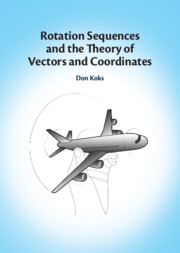Refine search
Actions for selected content:
3190 results in Mathematical Methods
Frontmatter
-
- Book:
- Rotation Sequences and the Theory of Vectors and Coordinates
- Published online:
- 17 April 2025
- Print publication:
- 24 April 2025, pp i-iv
-
- Chapter
- Export citation
7 - Rotation Sequences and the Fundamental Theorem
-
- Book:
- Rotation Sequences and the Theory of Vectors and Coordinates
- Published online:
- 17 April 2025
- Print publication:
- 24 April 2025, pp 171-220
-
- Chapter
- Export citation
8 - Coordinate Systems for Earth, and More Rotation Sequences
-
- Book:
- Rotation Sequences and the Theory of Vectors and Coordinates
- Published online:
- 17 April 2025
- Print publication:
- 24 April 2025, pp 221-259
-
- Chapter
- Export citation
1 - Setting the Scene
-
- Book:
- Rotation Sequences and the Theory of Vectors and Coordinates
- Published online:
- 17 April 2025
- Print publication:
- 24 April 2025, pp 1-6
-
- Chapter
- Export citation
9 - The Role of Quaternions in Rotation Theory
-
- Book:
- Rotation Sequences and the Theory of Vectors and Coordinates
- Published online:
- 17 April 2025
- Print publication:
- 24 April 2025, pp 260-302
-
- Chapter
- Export citation

Rotation Sequences and the Theory of Vectors and Coordinates
-
- Published online:
- 17 April 2025
- Print publication:
- 24 April 2025

Notes, Problems and Solutions in Differential Equations
-
- Published online:
- 15 April 2025
- Print publication:
- 05 June 2025
14 - Approximation Methods
-
- Book:
- Quantum Mechanics through Problems
- Published online:
- 05 December 2024
- Print publication:
- 12 December 2024, pp 433-515
-
- Chapter
- Export citation
6 - Mathematical Formulation of Quantum Mechanics
-
- Book:
- Quantum Mechanics through Problems
- Published online:
- 05 December 2024
- Print publication:
- 12 December 2024, pp 155-191
-
- Chapter
- Export citation
Acknowledgments
-
- Book:
- Quantum Mechanics through Problems
- Published online:
- 05 December 2024
- Print publication:
- 12 December 2024, pp xxi-xxii
-
- Chapter
- Export citation
7 - Physical Interpretation: Postulates of Quantum Mechanics
-
- Book:
- Quantum Mechanics through Problems
- Published online:
- 05 December 2024
- Print publication:
- 12 December 2024, pp 192-223
-
- Chapter
- Export citation
15 - Scattering by a Potential
-
- Book:
- Quantum Mechanics through Problems
- Published online:
- 05 December 2024
- Print publication:
- 12 December 2024, pp 516-581
-
- Chapter
- Export citation
Contents
-
- Book:
- Quantum Mechanics through Problems
- Published online:
- 05 December 2024
- Print publication:
- 12 December 2024, pp vii-xviii
-
- Chapter
- Export citation
9 - Particle in a Central Potential; Orbital Angular Momentum
-
- Book:
- Quantum Mechanics through Problems
- Published online:
- 05 December 2024
- Print publication:
- 12 December 2024, pp 270-290
-
- Chapter
- Export citation
13 - Addition of Angular Momenta
-
- Book:
- Quantum Mechanics through Problems
- Published online:
- 05 December 2024
- Print publication:
- 12 December 2024, pp 411-432
-
- Chapter
- Export citation
8 - The Harmonic Oscillator
-
- Book:
- Quantum Mechanics through Problems
- Published online:
- 05 December 2024
- Print publication:
- 12 December 2024, pp 224-269
-
- Chapter
- Export citation
5 - Scattering in One Dimension
-
- Book:
- Quantum Mechanics through Problems
- Published online:
- 05 December 2024
- Print publication:
- 12 December 2024, pp 94-154
-
- Chapter
- Export citation
12 - Spin; Charged Particle in an Electromagnetic Field
-
- Book:
- Quantum Mechanics through Problems
- Published online:
- 05 December 2024
- Print publication:
- 12 December 2024, pp 365-410
-
- Chapter
- Export citation
1 - The Failure of Classical Physics
-
- Book:
- Quantum Mechanics through Problems
- Published online:
- 05 December 2024
- Print publication:
- 12 December 2024, pp 1-17
-
- Chapter
- Export citation
Index
-
- Book:
- Quantum Mechanics through Problems
- Published online:
- 05 December 2024
- Print publication:
- 12 December 2024, pp 756-762
-
- Chapter
- Export citation
